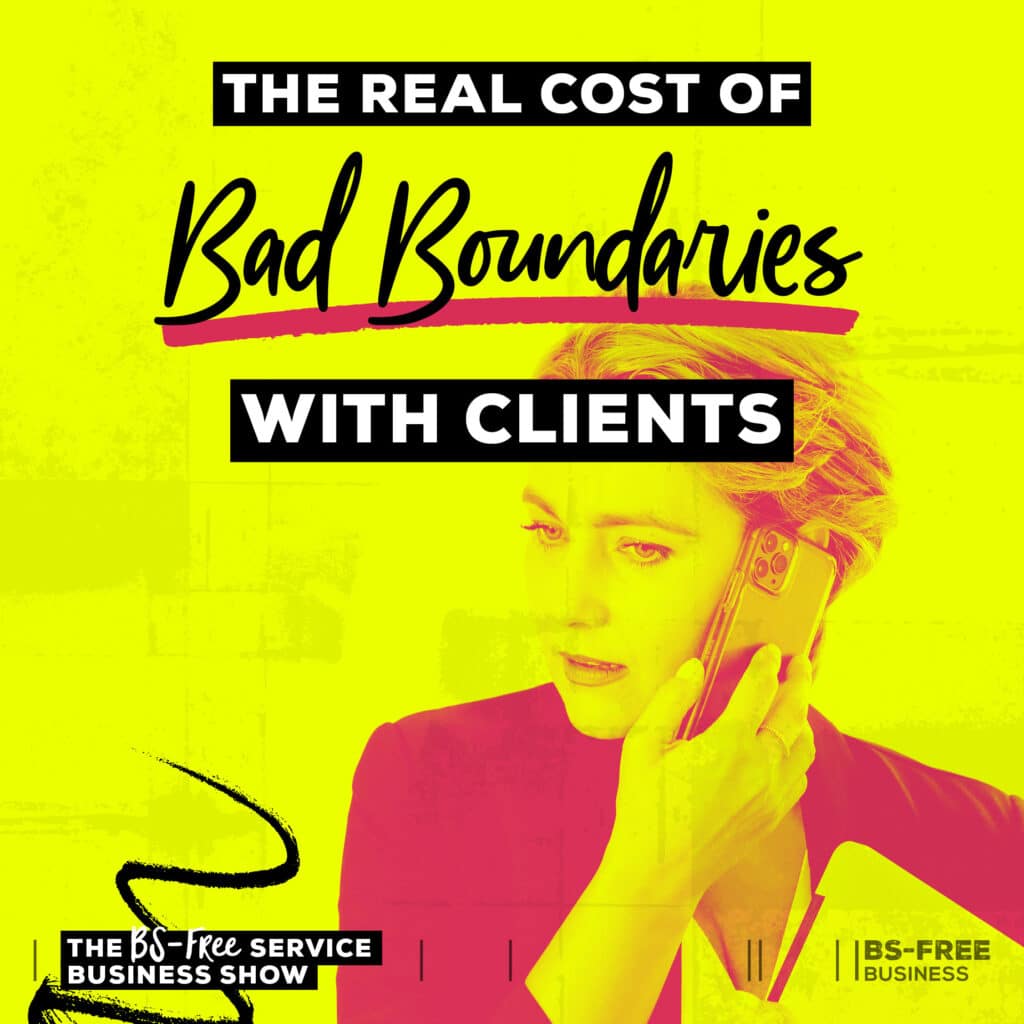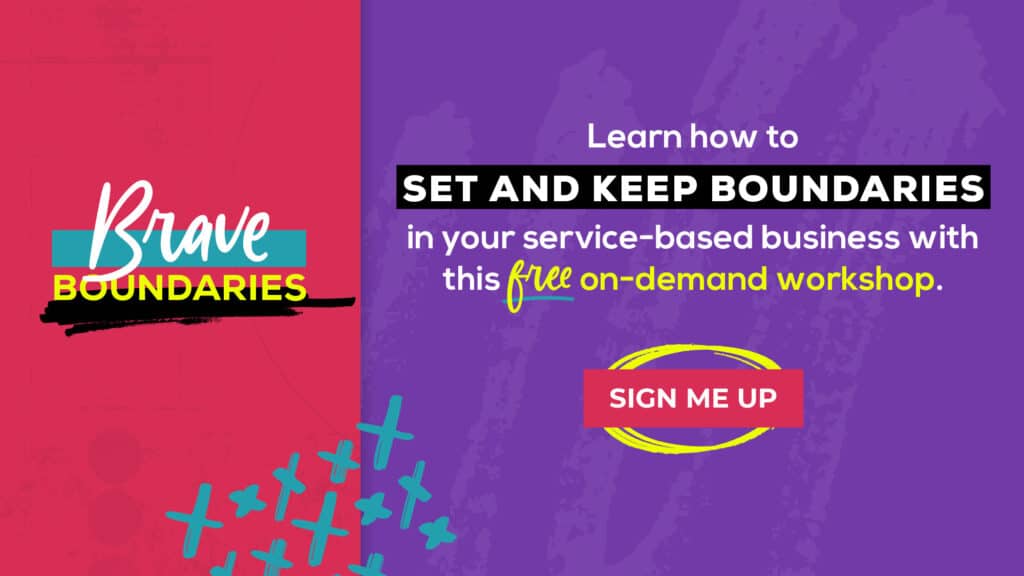
Search the site:
The Real Cost of Bad Boundaries with Clients
Have you ever worked overtime, sacrificing your personal time and energy, all because you couldn’t say no to a client’s demands? Or are you constantly battling scope creep, struggling to maintain control over your projects and protect your bottom line?
From draining your time and energy to wreaking havoc on your mental health and bottom line, poor boundaries can turn your dream business into a nightmare faster than you can say, “Scope creep!” In this episode, we’re looking at the real cost of “bad” boundaries with clients and how to build healthier, more sustainable client relationships.
Have you ever had that client who doesn’t seem to understand where the line is? Yeah, we’ve all been there.
But guess what? While it’s easy to complain about clients, we have a critical role. Setting boundaries ain’t just about reacting when someone’s already trampled all over them; it’s about laying out the rules of engagement from day one and ensuring everyone’s on the same page.
Having boundaries is essential as a service business owner. And not just with nightmare clients from the fiery pits of hell (you know the ones that make you question your choice to run a business in the first place), but with all of our clients.
From the client who just asks for one more thing to the everyday situations that grind your gears, serving clients can wear on you. Not having clear boundaries can cost you much more than you’d expect.
What Are Boundaries with Clients?
One of my biggest pet peeves is when people use boundaries to avoid serving their clients. That’s not what boundaries are, despite what those celebrity entrepreneurs may pretend.
So, what are boundaries? Boundaries with clients are the limits and guidelines you use as a service provider to establish a professional relationship with your clients. These boundaries aim to ensure a respectful relationship that works for everyone.
Your boundaries should help you balance serving client needs and protecting your well-being, schedule, and business interests.
Your client boundaries may include communication, time commitments, scope of work, deadlines, pricing and payments, and even professional conduct. Clearly defining expectations of how you work together creates healthy working relationships with your clients.
When you have weak, unclear, or non-existent boundaries, multiple aspects of your business may be impacted. There’s always a cost of “bad” boundaries with your clients.
Common Examples of Bad Client Boundaries
Before discussing the cost of bad boundaries to you and your business, I want to touch on some of the most common examples of bad client boundaries. You may hear some of these and feel personally attacked, but that’s not my intention.
These are the typical examples service business owners may struggle with at different stages of their business or even on an ongoing basis. Even as a very experienced service provider, I occasionally need a refresher.
Our boundaries are a constant work in progress as business owners. This was my inspiration for this episode, as the more you understand how boundaries impact you, the more likely you are to take steps to fine-tune them and make an ongoing effort to stick to them.
Availability
How available are you to your clients? You need to have set work hours and not fall into the trap of being constantly available.
Personal Space Invasion
Do you allow your clients to intrude on your personal time? Call or message you outside of your work hours? Ask for you to work on the weekend or even on your vacation?
Scope Creep/Overservicing
It’s really easy to fall into the trap of overservicing your clients or not sticking to the scope of work. There’s a difference between the occasional exception and constantly providing work for free.
Underpricing
Pricing your services too low consistently is a boundary issue. Whatever the reason you undercharge, you need to be aware of how this impacts you over time. You don’t owe anyone a “deal” and getting a no from a potential client is okay.
Communication
Your clients should know how to best communicate with you, provide feedback, and so forth. As a service provider, you want to communicate timelines and progress proactively.
Overpromising
Do you fall into the trap of agreeing to unrealistic deadlines? Or saying yes to things you don’t have any business doing? Before you say yes, consider how it will impact you.
Difficulty Saying No
People pleasers unite! If you can’t say no to work from clients, or requests, or anything else, you need to learn how to say no.
Failing to Enforce Boundaries
Once you set boundaries, you need to stick to them. You need to take your own medicine, from payments to late fees to deadlines, to communication channels.
Accepting Disrespectful Behavior
Tolerating disrespectful or abusive behavior from clients instead of establishing boundaries for professional conduct.
Building a service business that actually serves you and is sustainable relies on you having these client boundaries handled.
The Real Cost of Poor Client Boundaries: Time & Money
When you think about your client boundaries, it’s easy to fall into the trap of going along to get along. So many times, we decide that it’s easier just to accept how things are with our clients versus taking proactive steps to change it.
I’m far from perfect in my client relationships. While I generally don’t have a problem with boundaries, sometimes I decide I don’t have the time, energy, or emotional capacity to deal with resetting boundaries with a client. But then I realized that if I don’t handle it, it’s going to cost me.
When you think about the cost of “bad” boundaries, you may struggle to pin down exactly what they are as so many times they’re intangible. It’s hard to put a number to how you feel when a client asks for one more thing or you don’t like a client’s tone.
Some boundaries are easier to nail down the cost of, especially the ones related to your time and money.
Underpricing
For example, when we underprice our services or do work for free, we’re devaluing our precious time. Typically, we don’t set out to do these things, but charging too little or allowing too many extras to sneak into a project accumulates over time.
Maybe you have a long-term client whose retainer is priced at your rate from three years ago. Every week, every month, that cost adds up, impacting your revenue. You could be working with another client with a clearer scope of work at a higher rate.
Scope Creep
Scope creep is a tangible (and very common) cost of weak client boundaries. If you’re constantly overservicing your clients, they’re eating away at time you could use for other client projects while degrading your hourly rate or overall revenue.
Honestly, scope creep is one of the trickiest boundaries as you may find it barely noticeable. I recommend a time-tracking exercise if you’re unsure where your time is going and suspect you may have scope creep.
If you’re constantly over budget with your clients and not charging them for those services, it’s costing you. This is a persistent problem for many service business owners, but it’s one you absolutely want to handle.
Payment Policies
A non-negotiable boundary should be around your payments from clients as this can too easily lead to cash flow problems. Having clear payment policies that you establish from day one with clients is essential. Your contracts should include contingencies for late payments or the ability to stop work as you don’t want to find yourself in a situation where a client defaults on paying you.
Infringing on Personal Time
This cost is self-explanatory, and even if you don’t mind, it costs you. Work gets interjected into your non-work time, and that takes up valuable real estate in your head. Also, this can make you resentful, frustrated, or disrespected by your clients, which impacts your working relationship.
If this is an issue, consider communicating your availability, office hours, and standard response times. Then, don’t breach your boundaries, as if you want clients to stick to them, you need to do the same.
Deadlines and Timelines
Every service business owner knows that failing to manage deadlines and timelines with clients can come with a hefty price tag. Your boundaries around deadlines and timelines impact your productivity and profitability.
If you have a client who consistently misses deadlines to provide input on a project but then wants you to turn around work quickly, that has a material impact on your schedule. And it can potentially cost you time that you may be working on other projects.
Your clients judge you on your ability to deliver on time, so constantly managing expectations on deadlines/timelines ensures things go smoothly.
Remember that as part of your contracts, it’s entirely reasonable for you to set boundaries around any changes to the timeline. This may be charging fees for project delays or rebooking fees to help ensure you’re not held hostage by a client’s choice to stretch things out.
Communication
Finally, communication serves as a crucial boundary tied to time management. It’s all about setting clear guidelines regarding how, when, and why you connect with clients.
If you’re a designer and you communicate with clients via your project management system, you must ensure they stick to that plan. You don’t want them emailing you and DM-ing you on Instagram. That fragmented communication wastes energy and time as you try to corral everything.
One communication boundary I’ve had to put in place in my agency is how we receive feedback on our work. We ask that clients provide feedback via comments and/or tracked edits in Google Docs, vs. asking for a phone call to review live.
These types of boundaries ultimately prevent you from constant interruptions and time wasters throughout your day.
Other Costs of Bad Boundaries
Time and money-related costs of bad boundaries are the easiest to quantify, but what about the less tangible ones?
Yes, I’m talking about personal costs like emotional exhaustion, drained energy, and even impact on your self-esteem. You may not even realize the toll the lack of boundaries is taking on you over time.
When you think about your capacity, you likely immediately think about your available time for client work but not your energetic, emotional, and sensory capacity. Perhaps you have a client who’s always crossing your boundaries, and it’s fine until one day it’s finally not, and you’re ready to burn down your business as a result.
If you constantly feel resentful, frustrated, irritated, stressed, or anxious due to your client work, that may be a sign that you need to adjust or enforce your boundaries. Being complacent or avoidant will only allow those feelings to accumulate over time.
No matter how you feel, there’s always an opportunity to set or reset boundaries with your clients. The last thing you want to do is for this to worsen over time so it’s bleeding over into how you feel about yourself or placing a strain on your interpersonal relationships.
That’s where you really start to see the cost of not setting boundaries with clients. You may experience a loss of motivation, and resentment for your work or clients and feel like you’re compromising your values, ethics, or professional integrity.
No client is ever going to be worth it. While you need to make a living, there will always be another way to generate revenue without such steep costs.
From my point of view, one of the biggest reasons service business owners end up burnt out can be chalked up to not having strong enough boundaries.
Constantly overextending yourself and letting people violate your boundaries (or simply not having any boundaries) is a recipe for burnout. And I don’t mean burnout in how people talk about it online where they need a day off, but true, persistent burnout.
Burnout is a state of emotional, mental, and physical exhaustion that can’t be fixed with a few days off.
If you’re feeling cynical, perpetually exhausted, and like doing your work is a struggle, you may be experiencing burnout. I’m not an expert on this topic, but this is the true cost of bad boundaries with clients.
Signs you may be experiencing burnout include feeling:
- Depleted despite adequate rest and sleep.
- Detached or disconnected from your work
- Like your performance is declining and you can’t meet commitments.
Boundaries aren’t the only way to address burnout, but they’re a critical component of ensuring that you don’t find yourself in a constant cycle of recovery and burnout.
Even if you’re not feeling burnt out, your boundaries with clients are critical to the sustainability of your service business.
How to Set Boundaries with Clients
Let’s wrap this up with some real talk. Setting boundaries with clients isn’t just about putting up barriers; it’s about keeping your well-being intact while ensuring your bank account doesn’t take a hit. Your boundaries are about
protecting your precious time, your hard-earned cash, and most importantly, your mental health.
As service business owners, we need to acknowledge the true cost of ignoring boundaries – losing out on that much-needed vacation time or feeling stuck in an endless cycle of client demands. Your boundaries make or break your ability to create a simple and sustainable business for years to come.
So your homework from this episode is to think about what boundaries you need to thrive, and how you can set the stage for mutual respect and collaboration with your clients.
To help you do that, you’ll want to check out the Brave Boundaries workshop which you can grab for FREE. This quick workshop builds on what we talked about in this episode.
Links for this episode:
- Sustainable Systems: Tame the Client Service Chaos
- 3 Tips to Better Manage Client Expectations
- Staying Solo: Carving Out Consistent Space


I’m Maggie Patterson (she/her), and services businesses are my business.
I have 20+ years of experience with client services, am a consultant for agency owners, creatives, and consultants, and vocal advocate for humane business practices rooted in empathy, respect, and trust.
Read or Listen to the Latest
For Solo Business Owners

Growing a solo service business is tough.
It’s even harder when you’re bombarded with BS advice that steers you away from your values and why you started your business in the first place.
This is the podcast for solo creatives and consultants who want to remain as a team of one and have zero interest in the hustle and grind of typical business teachings.
Subscribe now and never miss an episode.
For Micro Agency Owners
Most podcasts for agency owners obsess over revenue growth as the ultimate success metric.

But here’s the truth: not everyone wants to make millions. Your goal might be to build a sustainable business that lets you have a life and doesn’t run you into the ground.
Join me as I spill my shameless confessions and share everything I’ve learned about building a micro agency that skips the BS of tired and typical agency teachings.
Follow Now on All Major Podcast Platforms








